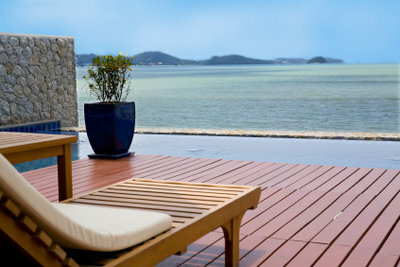Lay Bangkirai on terrace
The Bangkirai wood is ideal for terrace design. Bangkirai has a very long lifespan and is characterized by its variety of colors from light brown to dark red-brown. This play of colors brings life to your garden. There are a few things to consider when laying Bangkirai on the terrace.

What you need:
- drilling machine
- Cordless screwdriver
- Circular saw
- Guide rail
- To force
- Pull bar
- Tension straps
- Spacers
- Stainless steel screws
- Hardwood drill bit with countersink, square measure, chalk line, belt sander
- line
How to properly lay Bangkirai
First of all, you should pre-drill all Bangkirai planks to prevent the screws from pulling out.
Always use stainless steel screws (V2A).
In order to prevent the formation of cracks on the cut edges, the cut edges can be treated with waterproof glue afterwards.
Use a hard type of wood for the substructure as well. Otherwise, waves on the terrace develop.
When laying, always leave 3 mm space between the boards.
Like any other type of wood, Bangkirai wood will turn gray over time if it is not treated with a special care oil. Various care oils for Bangkirai wood are available in stores. These should be applied in several layers 1-2 times a year.
When using Bangkirai, it is essential to pay attention to surrounding components (walls, facades)! The longevity of Bangkirai wood is due to its oily ingredient. This usually occurs after the first weather phase. If surrounding components come into contact with this ingredient, it is difficult to remove again. A treatment with a special care oil for Bangkirai wood before the first weather phase can help.
The construction of the substructure depends on the strength of the Bangkirai planks. As a rule, you shouldn't skimp on the substructure. Too great a distance does not lead to a good running feeling.
With a board spacing of 45 cm x 70 cm, you are always on the safe side.
A level surface is required for the substructure. If necessary, this area is made level with gravel. You should lay a layer of fleece under the gravel so that the weed cannot grow through.
The substructure is anchored to the ground. Various methods are possible here.
When laying the boards, a 1 to 2 percent gradient in the direction of the grooves should be observed so that the rainwater can drain off better.
If you attach the terrace to a wall, there must be a clearance of at least 1 cm between the wall and the terrace. The Bangkirai planks must not come into contact with iron, otherwise unsightly discoloration will occur.
Make sure that each end of the board is supported with a support beam and screwed in with 2 screws. The distance from the screws to the end of the board must be at least 2 centimeters and a maximum of 5-7 centimeters. The screw heads must be flush with the fluted groove.
With wedges, tension belts, tension bars and clamps, irregularities in the middle of the boards are leveled out and brought into position. Then a cord is stretched for the remaining screws and the remaining screws are screwed to the support beam.
With a circular saw and guide rail (fitted with HM) you can cut the end of the decking to the desired length. Then you can use a planer (electric or hand planer) or a belt sander to provide the ends of the decking with a 45 degree bevel.
If you have your own home with a garage right next to the house, you can ...
How helpful do you find this article?

